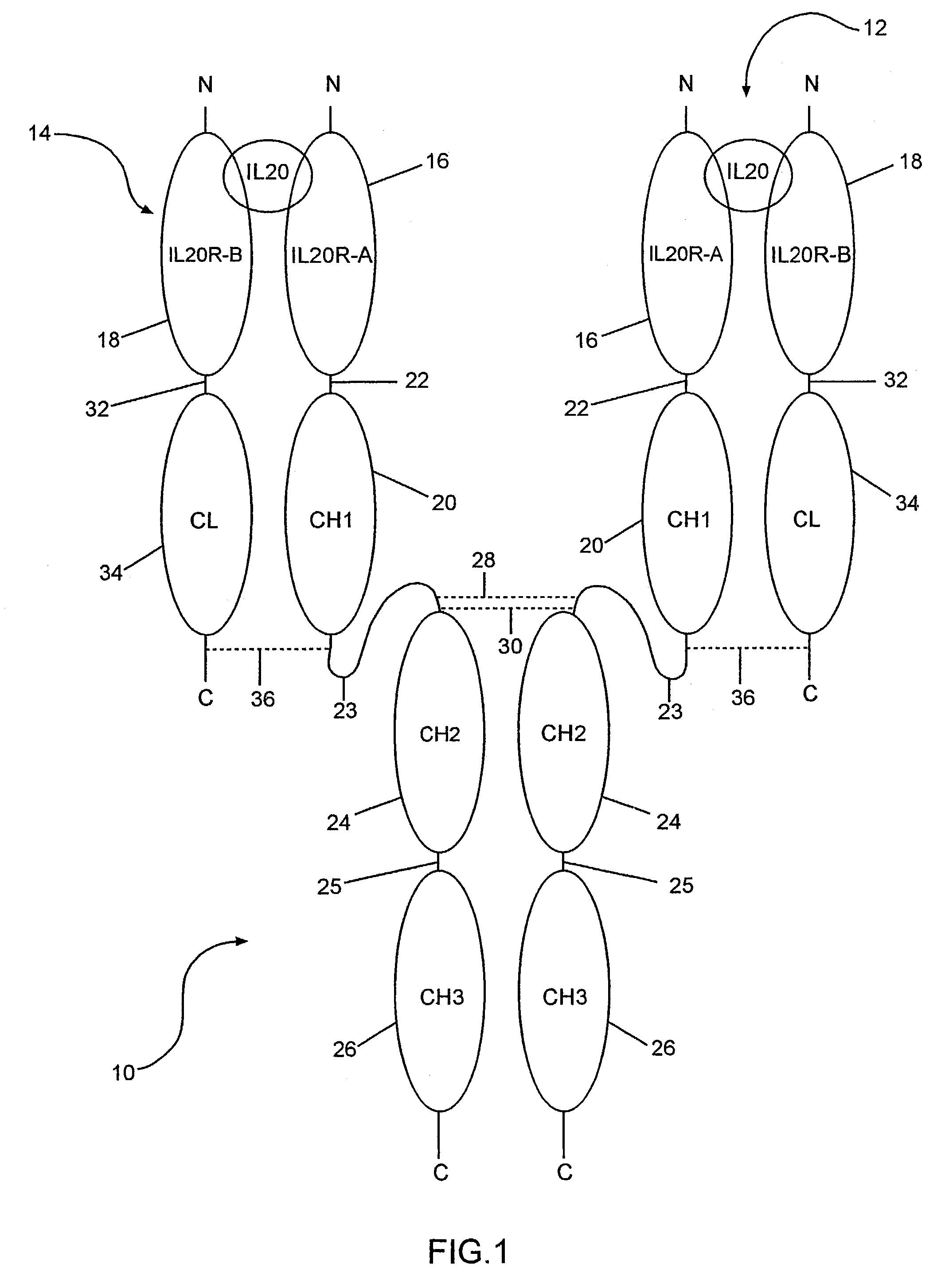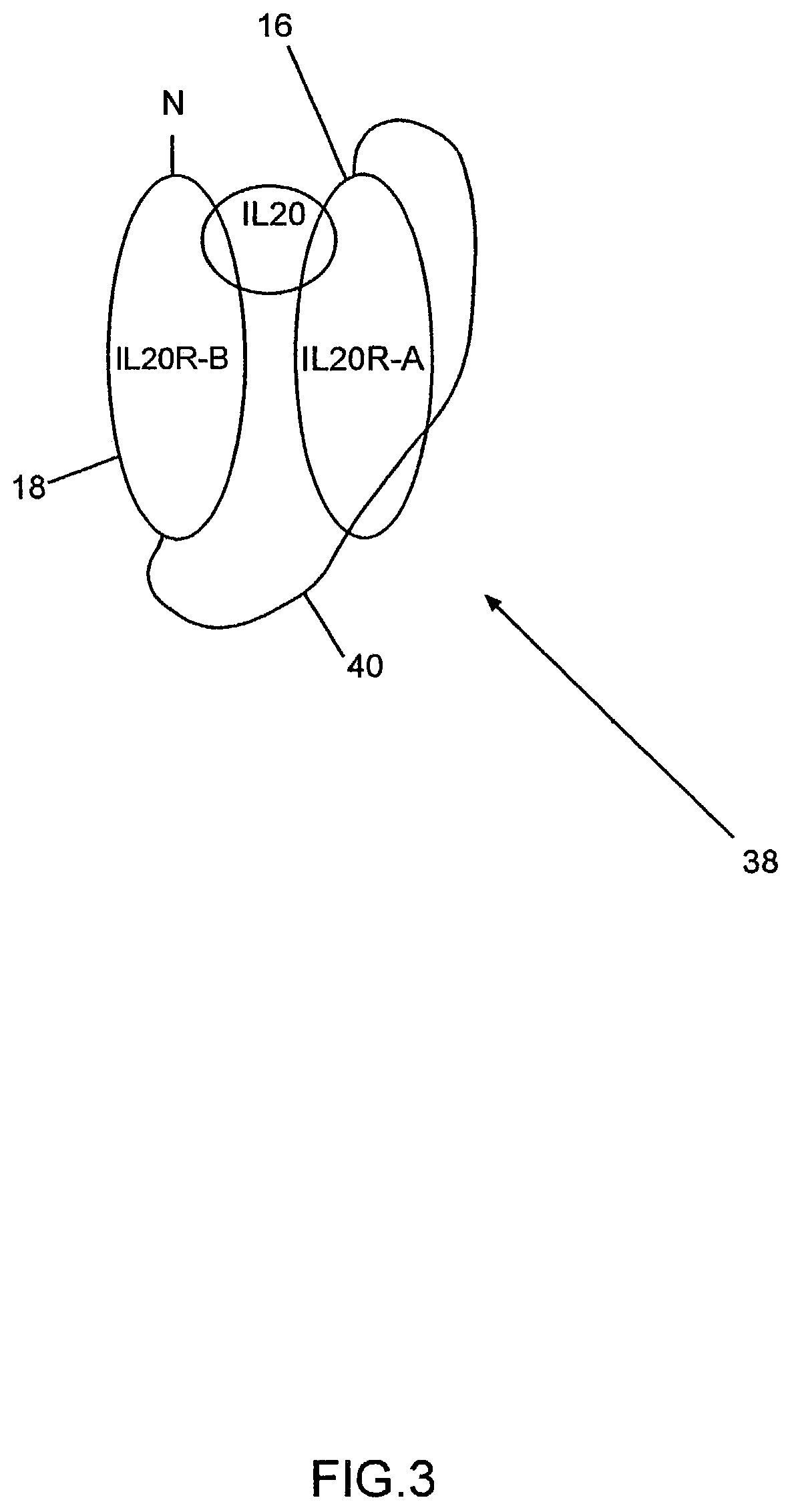Method for treating inflammation
a technology for inflammation and treatment, applied in the field of inflammation treatment, can solve the problems of inflammatory reaction, compromising the host, and morbidity and mortality in humans, and achieve the effects of reducing inflammation, reducing inflammation, and improving immune function
- Summary
- Abstract
- Description
- Claims
- Application Information
AI Technical Summary
Benefits of technology
Problems solved by technology
Method used
Image
Examples
example 1
Up-Regulation of IL-8 by IL-20
Methods:
[0060]Normal Human Epidermal neonatal keratinocytes (NHEK) (from Clonetics) at passage 2 were plated and grown to confluency in 12 well tissue culture plates. KGM (Keratinocyte growth media) was purchased from Clonetics. When cells reached confluency, they were washed with KGM media minus growth factors=KBM (keratinocyte basal media). Cells were serum starved in KBM for 72 hours prior to the addition of test compounds. Thrombin at 1 I.U. / mL and trypsin at 25 nM were used as positive controls. One mL of media / well was added. KBM only was used as the negative control.
[0061]IL-20 was made up in KBM media and added at varying concentrations, from 2.5 μg / ml down to 618 ng / mL in a first experiment and from 2.5 μg / mL down to 3 ng / mL in a second experiment.
[0062]Cells were incubated at 37° C., 5% CO2 for 48 hours. Supernatants were removed and frozen at −80° C. for several days prior to assaying for IL-8 and GM-CSF levels. Human IL-8 Immunoassay kit # D...
example 2
Cloning of IL-20RB
Cloning of IL-20RB Coding Region
[0064]Two PCR primers were designed based on the sequence from International Patent Application No. PCT / US99 / 03735 (publication No. WO 99 / 46379) filed on Mar. 8, 1999. SEQ ID NO: 16 contains the ATG (Met1) codon with an EcoRI restriction site, SEQ ID NO: 17 contains the stop codon (TAG) with an XhoI restriction site. The PCR amplification was carried out using a human keratinocyte (HaCaT) cDNA library DNA as a template and SEQ ID NO: 16 and SEQ ID NO: 17 as primers. The PCR reaction was performed as follows: incubation at 94° C. for 1 min followed by 30 cycles of 94° C. for 30 sec and 68° C. for 2 min, after additional 68° C. for 4 min, the reaction was stored at 4° C. The PCR products were run on 1% Agarose gel, and a 1 kb DNA band was observed. The PCR products were cut from the gel and the DNA was purified using a QIAquick Gel Extraction Kit (Qiagen). The purified DNA was digested with EcoRI and XhoI, and cloned into a pZP vector ...
example 3
Binding of IL-20 to IL-20RB / IL-20RA Heterodimer
[0066]A cell-based binding assay was used to verify IL-20 binds to IL-20RA-IL-20RB heterodimer.
[0067]Expression vectors containing known and orphan Class II cytokine receptors (including IL-20RA and IL-20RB) were transiently transfected into COS cells in various combinations, which were then assayed for their ability to bind biotin-labeled IL-20 protein. The results show IL-20RB-IL-20RA heterodimer is a receptor for IL-20. The procedure used is described below.
[0068]The COS cell transfection was performed in a 12-well tissue culture plate as follows: 0.5 μg DNA was mixed with medium containing 5 μl lipofectamine in 92 μl serum free Dulbecco's modified Eagle's medium (DMEM) (55 mg sodium pyruvate, 146 mg L-glutamine, 5 mg transferrin, 2.5 mg insulin, 1 μg selenium and 5 mg fetuin in 500 ml DMEM), incubated at room temperature for 30 minutes and then added to 400 μl serum free DMEM media. This 500 μl mixture was then added to 1.5×105 COS ...
PUM
| Property | Measurement | Unit |
|---|---|---|
| concentrations | aaaaa | aaaaa |
| concentrations | aaaaa | aaaaa |
| temperature | aaaaa | aaaaa |
Abstract
Description
Claims
Application Information
 Login to View More
Login to View More - R&D
- Intellectual Property
- Life Sciences
- Materials
- Tech Scout
- Unparalleled Data Quality
- Higher Quality Content
- 60% Fewer Hallucinations
Browse by: Latest US Patents, China's latest patents, Technical Efficacy Thesaurus, Application Domain, Technology Topic, Popular Technical Reports.
© 2025 PatSnap. All rights reserved.Legal|Privacy policy|Modern Slavery Act Transparency Statement|Sitemap|About US| Contact US: help@patsnap.com



